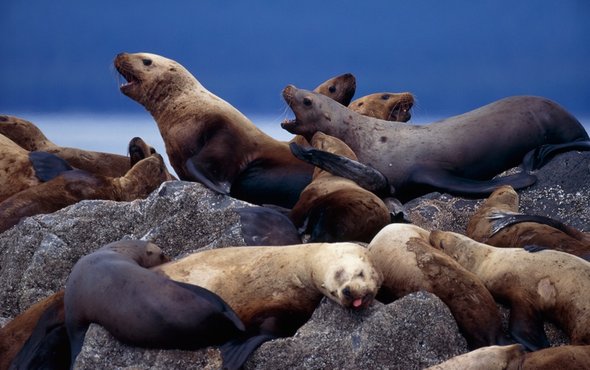(单词翻译:单击)
听力文本
This is Scientific American — 60-Second Science. I'm Jason G. Goldman.
Cabo Polonio is a small seaside village on Uruguay's Atlantic coast. The permanent, year-round population is just 95 people living in around 50 homes. Another 350 homes are used between December and February—by tourists hoping to see pinnipeds—
(sea lion sounds)
—fur seals and sea lions that haul out on the town's rocky cape.
In January alone, more than 30,000 tourists visit. What are the impacts of so many tourists on these marine mammals? Between 1996 and 2014, European and South American biologists monitored both the animals and the people to find out.
Over that time span, the pinnipeds' tolerance for human disturbance declined. When annoyed, they move further away from the tourist viewing area or even dive back in the water to swim away. Those responses are contrary to the common assumption that wildlife becomes habituated to human activities. The study is in the journal Applied Animal Behaviour Science.

The researchers think that a fence, initially constructed in the late 1990s, is to blame. It was built with good intentions, to keep people a safe distance from the colony. But the fence isn't long enough to keep people away from the most critical part of the habitat. It might even funnel people towards that area, as they try to find viewing spots closer than the fence would allow.
Or it could be that the fence actually does its job keeping people away. But as a result, they are just far enough away that the animals never really get used to them.
The truth is that pinnipeds seem to be doing well in Uruguay. While the amount of animals in the rookery varies day by day, the best estimate is there's now around a thousand of them—more than there were 20 years ago. But it's hard to say whether tourism has played any role in that increase. The animals have also become protected from hunting under Uruguayan law. And there are environmental factors at play in governing their population, like prey availability and climate change.
Still, the study tells us two things. First, photographic wildlife tourism may not always be as low-impact as assumed. Second, ecotourism developers should get input from social psychologists: who can help anticipate the behaviors of the visiting humans, as they observe the behaviors of the native wildlife.
For Scientific American — 60-Second Science. I'm Jason G. Goldman.
参考译文
这里是科学美国人——60秒科学。我是杰森·古德曼。
凯博波洛尼奥是乌拉圭大西洋沿岸的一个海滨小镇。全年常住人口仅有95人,分别居住在50个家庭中。另外350处住宅,在12月至2月期间供前来观赏鳍足类动物的游客居住。
(海狮的声音)
——毛皮海豹和海狮出没于镇上的岩石海角。
仅1月份就有超过3万名游客来此观光。如此多的游客会对这些海洋哺乳动物产生什么影响?为了找到答案,欧洲和南美生物学家在1996年至2014年间对这里的动物和人类进行了监测。
在这段时间内,鳍足类动物对人类干扰的容忍度降低了。当这些动物被人类干扰后,它们会远离游客观赏区,甚至潜入水中游走。这些反应与“野生动物习惯于人类活动”这种人类的常见预想相悖。这项研究结果发表在《应用动物行为科学》期刊上。
研究人员认为,这要归咎于最初在上世纪90年代后期建造的那个栅栏。建造这个栅栏的意图是好的,目的是让人类与动物栖息地保持安全距离。但是由于栅栏不够长,无法让人们远离栖息地的最核心区域。而在人们试图突破栅栏的限制,寻找更近的观察点时,栅栏甚至可能将人们引向核心区域。
也有可能栅栏的确将人群与动物隔开了。但是结果是,人群与动物相隔太远了,以致于动物从未真正习惯人类的观赏。
事实上,乌拉圭鳍足类动物的数量的确有所增长。栖息地中的动物数量每天都在变化,而最佳估计值约为1000只,这比20年前的数量还多。但很难说旅游业是否在动物数量的增长上发挥了作用。依据乌拉圭法律,这些动物受到保护,免于捕猎。在控制动物数量方面,猎物可能性和环境变化等环境因素也产生了一定影响。
不过,这项研究告诉了我们两件事。其一,野生动物摄影游的影响可能并不总是如设想的那样小。其二,生态旅游开发者应该听取社会心理学家的建议:他们可以帮助预测游客的行为,就像他们观察本土野生动物的行为一样。
谢谢大家收听科学美国人——60秒科学。我是杰森·古德曼。
译文为可可英语翻译,未经授权请勿转载!
重点讲解
重点讲解:
1. be contrary to 相反的;相对的;
The results are contrary to expectations.
结果和预期的相反。
2. be habituated to (人)习惯于…的;
By the end of winter, he was habituated to cold.
冬末之际,他已习惯于寒冷。
3. get used to sth./doing sth. 开始习惯于;
You quickly get used to using the brakes.
你很快就会习惯使用刹车的。
4. day by day 日益;逐日;
It's getting warmer day by day.
天气越来越暖和了。


